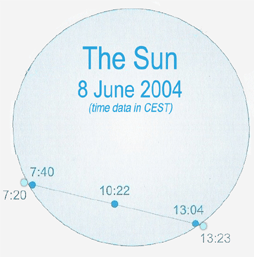
The Venus transit is one of the rarest astronomical events. It is actually an eclipse of the Sun disk caused by the planet Venus as observed from the Earth. It is based on the fact, that Venus and the Earth circle the Sun almost in a plane (the ecliptic plane). It may therefore happen, that Venus gets to the imaginary line connecting the Earth and the Sun and it can be observed as a dark dot on the Sun background. This event can be regularly observed in intervals 8; 12,5; 8 ; 105,5 years. If you didn´t have the opportunity to watch the Venus transit of June, the 21st century will give you another chance for Venus transit observation on 6th June 2012.
How does the event look like? As the Venus approaches the Sun, a thin stripe of gas atmosphere starts to shine around it. This is followed by an external contact and an internal contact just a few minutes later. After that the Venus will slowly transit the Sun disk for several hours until the third contact occurs, which is followed by the last external contact and a gradual withdrawing from the Sun. Considering the slight size of Venus on the sky (58,2") it is much better to observe this event at the observatory or at least with an amateur telescope. Nevertheless it is possible to see it with the naked eye, naturally protected with special eclipse glasses.
We have already learned that the Venus transit occurs periodically. Our ancestors had therefore the opportunity to observe this event as well as we have. The first references to the observation of the Venus transit come from the year 1639 from an English clerk Jeremiah Horrocks. They refer to the transit of 6th December 1639.
In the following centuries the observations became a way to set the Earth-Sun distance (1 astronomical unit; AU) on the basis of a simple trigonometric calculation (see picture below). The names James Gregory and Edmund Halley are connected with the principle of this meassuring in the first place. Nevertheless, these scientist didn´t have enough accurate information at their disposal to make this calculation.

In the year 1761 the Russian astronomer Mikhail Lomonosov observed a thin stripe of light around Venus as it was approaching the sun disk. These observations gave him an idea, that this halo could be the atmosphere of the planet, which was later confirmed. Venus has a gas atmosphere, formed of carbon dioxide.
The year 1882 brought very precise estimations of the length of the astronomical unit, thanks to the amount of information collected by the scientists in connection with the Venus Transit. In the 60s this value was set (with radio waves) to 149 597 892,3 km with possible uncertainity less than 2 km.
The 20th century brought even more precise measuring of the AU and prooved the existence of the atmosphere of Venus. From the present view the observation of the Venus transit hasn´t got any scintific importance anymore. Nevertheless, we can enjoy its beauty and follow the steps of great astronomers of the past. In connection with this year´s transit the international project Venus Transit 2004 was created. A part of this project was to repeat the astronomical unit estimation based on the observation of the Venus transit like the scientists in the 18th and 19th century did. The information needed for the calculation should have been then collected by amateur astronomers from all around the world.
We were watching the Venus transit as a part of a public observation at the observatory in Karlovy Vary. About fifteen enthousiastic astronomers lead by the director of the observatory Miroslav Spurný met there. All of them had the opportunity to use several different methods of observation. The observatory´s main telescope served for webcasting, so we were mostly watching the transit through static telescopes. This method was supplied with observation through special glasses, borrowed from employees of the observatory, and with a vertical projection, which was probably the most impressive observation of the transit, that we have seen at the observatory. The observations were supplied with an improvised lecture, which was held by the observatory´s employees, who were aware of the friendly atmosphere. This atmosphere and a very comforting conditions put the finishing touches of our great impression from observing the unique event.

| Time of the contacts measured (CET): Contact I 7:20:11 Contact II 7:40:51 Contact III 13:04:05 Contact IV 13:23:27 |
Geographical coordinates of the observatory: 12° 54´ 25,5´´ Longitude east 50° 12´ 56,1´´ Latitude north |
